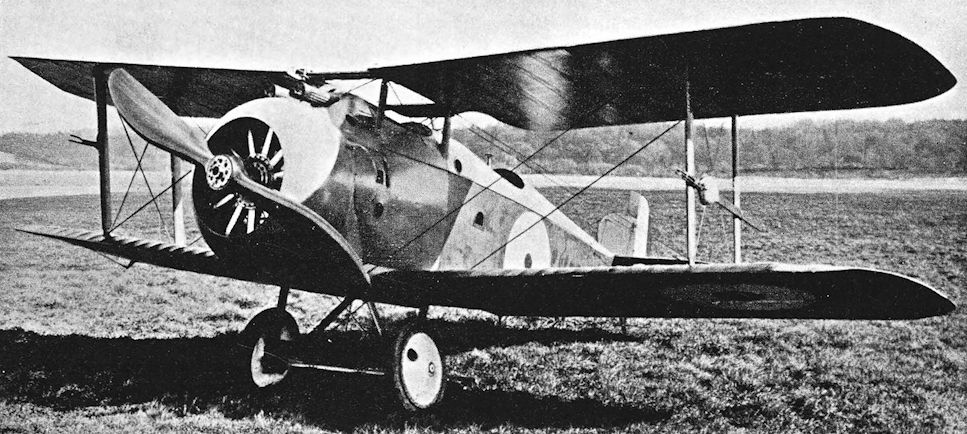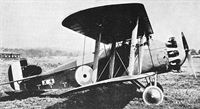
Описание
Страна: Великобритания
Год: 1918
Fighter
Варианты
- Sopwith - Hippo / 3F.2 - 1917 - Великобритания
- Sopwith - Bulldog / 2FR.2 - 1918 - Великобритания
- H.King Sopwith Aircraft 1912-1920 (Putnam)
- P.Lewis The British Fighter since 1912 (Putnam)
- F.Mason The British Fighter since 1912 (Putnam)
- W.Green, G.Swanborough The Complete Book of Fighters
- J.Bruce British Aeroplanes 1914-1918 (Putnam)
- H.King Armament of British Aircraft (Putnam)
-
J.Bruce - British Aeroplanes 1914-1918 /Putnam/
The first Sopwith Bulldog with Clerget engine and single-bay wings.
-
H.King - Sopwith Aircraft 1912-1920 /Putnam/
These three pictures have a special interest, not only in showing how remarkably clean and compact the first Bulldog appeared in its single-bay form and without its Lewis guns fitted, but in marking the apparent inauguration of the maker's system of numbering photographs, or negatives. The Sopwith caption to all three views reads: 'Sopwith Bulldog - 1 Bay - 1st. Machine - Type 2.F.R.2', and the prefixed numbers are S.6 (3/4 rear), S.7 (front) and S.8 (3/4 front).
-
H.King - Sopwith Aircraft 1912-1920 /Putnam/
These three views of the first Bulldog in its single-bay form but with Lewis guns fitted have the same maker's caption as those preceding. Their Sopwith numbers are S.12 (3/4 front), S.14 (3/4 rear). S.16 (front).
-
H.King - Armament of British Aircraft /Putnam/
The Sopwith Bulldog had unusual and heavy armament. In addition to two fixed Vickers guns there were two Lewis guns on pillar mountings. The foremost pillar was extensible and operated jointly with a protective screen.
-
P.Lewis - The British Fighter since 1912 /Putnam/
The first prototype Sopwith 2 FR.2 Bulldog Mk.I with single-bay wings and Clerget engine installation.
-
H.King - Sopwith Aircraft 1912-1920 /Putnam/
Rear and frontal aspects of the first Bulldog in two-bay form with horn-balanced ailerons. Sopwith caption to rear view reads: 'S.3 - Sopwith Bulldog - 2 Bay - 1st. Machine - Type 2.F.R.2". Front view caption is similar, but number is S.4.
-
J.Bruce - British Aeroplanes 1914-1918 /Putnam/
The second Sopwith Bulldog, as yet unmarked as X3, at Brooklands with two-bay wings and horn-balanced ailerons.
-
J.Bruce - British Aeroplanes 1914-1918 /Putnam/
The first (second ???) Bulldog as tested at Martlesham Heath numbered X3 and with plain ailerons.
-
J.Bruce - British Aeroplanes 1914-1918 /Putnam/
Sopwith Bulldog Mk. II with Dragonfly engine and close coaming about rear cockpit.
-
H.King - Sopwith Aircraft 1912-1920 /Putnam/
Clerget and Dragonfly engine installations compared. Sopwith caption (top) reads: "S.5 - Sopwith Bulldog - 2 Bay - 1st. Machine - Type 2.F.R.2'. Bottom. "S.505" (engine given as '360 hp A.B.C.' and dated 'June 24/18.')
-
H.King - Sopwith Aircraft 1912-1920 /Putnam/
Lacking armament, and with Dragonfly engine, the Bulldog II in this picture was captioned by Sopwith:'S.503 - Sopwith Bulldog 2.F.R.2 - 360 hp A B C. - June 24/18".
H.King Sopwith Aircraft 1912-1920 (Putnam)
2FR.2 Bulldog
Its close relationship to the Hippo notwithstanding, the Bulldog - especially in its very compact single-bay form was a fighter (or fighter-reconnaissance machine) of great individuality, the reconnaissance function implicit in the 'R' after the ‘F' having been envisaged in a possibly earlier, though more or less contemporary, design. This design was likewise Hippo-related, but was Hispano-Suiza powered, and was called Sopwith FR.2; it had two-bay wings with positive stagger and a slightly greater span than the Hippo, the measurement being 40 ft 3 in (12.2 m). Thus it would have been amenable to high-altitude operation with the camera and wireless that were specified for it, especially so as armament was to be lighter than that of the Bulldog in the form wherein this type materialised, the pilot having only one Vickers gun instead of two as actually fitted. A point of special interest is that, as in the earlier Armstrong Whitworth F.K.3 reconnaissance aircraft, the pilot (seated near the top-wing trailing edge) shared the same cockpit as the observer; and hardly less noteworthy is the fact that during the period 1917/18 new Sopwith two-seaters were built both with pillar-mounted rear armament (as on the F.K.3) and with the Scarff ring-mounting (as on the F.K.8).
In the form wherein it materialised, the Bulldog was designed during August/September 1917 - confusingly then called Buffalo, and allotted the construction-licence number 14, for like the Hippo, which had Licence No.16, it was a private venture.
The most striking point about this new two-seat fighter (for as a fighter it was primarily regarded, reconnaissance and contact patrol being subsidiary roles) was that it looked for all the world like a variant of the original Snipe, in particular by reason of its single-bay wings, but also in having twin Vickers guns. Certainly, with its span of only 26 ft 6 in (8 m) and length of 23 ft (7 m) it was about the most compact machine that could have borne its four-gun armament; yet even so, its vertical tail surfaces proclaimed descent (however indirect) from its pioneer forebear in the two-seat fighter field, the 1 1/2 Strutter - which, though considerably larger, had mounted only half the weight of armament.
That the stubby little wings were, in fact, too small to be true detracts but little from this first appraisal; and their inadequate surface may, in any case, be partly attributed to leading-edge and trailing-edge centre-section cut-outs (somewhat as in the Hippo) and even more so to the large gap between the spars through which the pilot's head protruded. The depth of the fuselage in this area was accentuated by a 'hump' fairing for the breech casings of the two synchronised Vickers guns; and thus the installation accorded closely with that of the Snipe. For each of the two guns there was a 600-round belt, and - so near the pilot's face were the ends of the breech casings that these were stoutly padded. Separate case and link chutes were let in to the cowling flanks and the windscreen was perforated for an Aldis sight. The apparent absence of trigger motors on the guns is not necessarily indicative of an intention to fit Sopwith-Kauper gear, or some other mechanical or electrical type, as standard; for had the Bulldog been produced in quantity, as was the Snipe, the C.C. hydraulic gear would doubtless have been specified. The matter may in any case have been an academic one, depending on the gun-timing provisions made, or allowed for, on the new Clerget 11Eb engine a powerplant unfamiliar in Britain and one that only the Hippo had in common.
Of greater interest was the gunner's armament, comprising two Lewis guns, one on a pillar mounting at each end of the elongated, forwardly-tapering cockpit. Having quoted from one's own writings in regard to the Hippo's armament, one now accords like treatment to the Bulldog. Thus:
'To extend the field of fire in the forward upper hemisphere, the front pillar was extensible, and, as it was projected upwards, it raised, by means of a connecting tube, a rectangular screen hinged to the rear spar of the upper centre-section. Jointly with a small windscreen, this afforded the gunner a measure of protection. The rear pillar could be traversed from side to side. Possibly in the interests of gun handling, the ammunition drums were of single (47-round) type. In the original armament scheme, which did not materialise, two Lewis guns were to be mounted between the cockpits, capable of firing, like the single gun actually fitted, above the airscrew. An attachment noted on the forward Lewis gun may indicate an intention that this gun could be fired also by the pilot, but this is conjectural.'
The Bulldog's heavy armament, it must be re-emphasised, was distributed over a very large portion of the original tiny single-bay version of the aircraft, and may well have accounted for heaviness both in weight and in control-forces that were clearly manifest by the end of 1917 air-testing having started in November of that year.
It is known that a new set of wings had been fitted as early as 13 November, 1917, but though these were of greater span and area and of two-bay rig, they were not of definitive form - incorporating, for instance, horn-balanced ailerons and probably having been intended as an alternative installation from an early stage. Strength was evidently to be compatible with the greater span, for, although the outer bays were braced by streamline-section 'Rafwires', the inner bays were sustained by stout wire cables. As tested on the Bulldog at Martlesham Heath during May 1918, however, the two-bay wings had no horn balances; nor was this the sole distinction, for the number X3 was now painted on the fuselage, as shown on photo.
At the time of the Martlesham Heath tests Bulldog X3 still had its two pillar-mounted Lewis guns, though a Scarff ring-mounting with a twin-gun attachment (or 'carrier' as the lining was called) was in prospect for a second specimen of the aircraft then in the Sopwith works. Another intended installation was that of an A.B.C. Dragonfly radial engine, of higher power than the Clerget 'Type 11 No. 3' to which a much-overgenerous output of 260 hp was credited for the official tests just mentioned.
As a potential replacement for the Bristol Fighter, and as such competitive with the Avro 530, the Bulldog was unleashed in mock combats against a 'Brisfit' and was found to be just about as manoeuvrable. Clearly, however, any worthwhile improvement in speed and climb must await the fitting of the Dragonfly, and a Clyno-built example of that engine was duly installed in Bulldog X4, the new combination being ready for testing in the second half of June 1918. By this time production of the Bulldog as a fighter was no longer contemplated, and X4 - or the Bulldog II as it was otherwise styled, to distinguish it from the Clerget-engined X3 Bulldog I was manifestly a flying test-bed. Not only was all armament deleted, but the coaming for the rear cockpit was carried high to make the occupant snug if not safe - for the Dragonfly-Bulldog was deplorably unreliable. Even so, this aircraft was flying at the Royal Aircraft Establishment, Farnborough (after undergoing various powerplant 'fixes' and at least one complete engine-change) as late as March 1919, having first arrived there on 25 June, 1918.
Although a third Bulldog had once been in prospect, work on this had long been stopped.
Bulldog I (200 hp Clerget 11Eb)
Span 33 ft 9 in (10.23 m): length 23 ft (7 m); wing area 335 sq ft (31 sq m). Empty weight 1.441 lb (653 kg); maximum weight 2,495 lb (1.132 kg). Maximum speed at 10.000 ft (3.050 m) 109 mph (175 km/h); maximum speed at 13,000 ft (3,960 m) 101.5 mph (163 km/h); climb to 5.000 ft (1.525 m) 6 min 5 sec: climb to 10.000 ft (3,050 m) 15 min 35 sec; climb to 15.000 ft (4.570 m) 38 min 55 sec; service ceiling 15,000 ft (4,570 m); endurance 2 hr.
N.B. All performance data for the Bulldog II Dragonfly test-bed would obviously vary greatly according to engine state, but the much-improved climb is implicit in the recorded time to 15,000 ft (4,570 m) of only 16 min 28 sec.
Описание:












